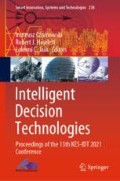Abstract
The modern stage of digital transformation of healthcare has defined the creation and application of intelligent decision support systems as one of the main tasks. The basis of systems of this class is the knowledge base management system, in which medical knowledge is formalized and accumulated. The medical knowledge representation model should adequately correspond to the decision-making process. The authors propose such a model based on the data flow graph described by means of combinatorial logic. As a unit of knowledge storage in the developed applicative-frame model is proposed that contains input attributes and a target attribute, the relationship between which is set by the application function. The decision inference procedure is a reduction of the tree of applicative frames. Formal reduction rules are given.
Access this chapter
Tax calculation will be finalised at checkout
Purchases are for personal use only
References
Xu, J., Xue, K., Zhang, K.: Current status and future trends of clinical diagnoses via image-based deep learning. Theranostics 9(25) (2019)
Shahid, N., Rappon, T., Berta, W.: Applications of artificial neural networks in health care organizational decision-making: a scoping review. PLoSONE 14(2), e0212356 (2019). https://doi.org/10.1371/journal.pone.0212356
Jovanović, M., Milenković, D., Perković, M, Milenković, T., Niković, V.: The use of artificial neural networks in clinical medicine. In: Sinteza 2016—International Scientific Conference on ICT and E-Business Related Research, pp. 112–117. Belgrade, Singidunum University, Serbia (2016). https://doi.org/10.15308/Sinteza-2016-112-117
Published Standards by ISO/TC215 “Health Informatics”. https://www.iso.org/committee/54960/x/catalogue/p/0/u/1/w/0/d/0
Abdali, S.K.: An abstraction algorithm for combinatory logic. J. Symbol. Logic 41, 222–224 (1976)
Carkci, M.: Dataflow and Reactive Programming Systems: A Practical Guide, 570 p. CreateSpace Independent Publishing Platform (2014). ISBN 9781497422445
Kent, A.: Dataflow languages. In: Encyclopedia of Library and Information Science: vol. 66—Supplement 29—Automated System for the Generation of Document Indexes to Volume Visualization, pp. 101–500. Taylor & Francis (2000). ISBN 9780824720667
Maurer, P.M., Oldehoeft, A.E.: The use of combinators in translating a purely functional language to low-level data flow graphs. Comp. Lang. 8(1), 27–45, 4.56 (1983)
Sharp, J.A.: Data Flow Computing: Theory and Practice, 566 p. Intellect, Limited (1992). ISBN 9780893919214
Van-Roy, P., Haridi, S.: Concepts, Techniques, and Models of Computer Programming, 900 p. Prentice-Hall (2004). ISBN 9780262220699
Johnston, W.M., Paul Hanna, J.R., Millar, R.J.: Advances in dataflow programming languages. ACM Comput. Surv. 36(1), 1–34 (2004)
Church, R.: The Calculi of Lambda-Conversion. Princeton (1941)
Curry, H.B., Feys, R., Craig, W.: Combinatory Logic, vol. 1. North-Holland, Amsterdam (1958)
Shortliffe, E.H.: Computer-Based Medical Consultations: MYCIN. Elsevier/North Holland, New York NY (1976)
Robinson, D.F., Foulds, L.R.: Comparison of phylogenetic trees. Math. Biosci. 53(1–2), 131–147 (1981). https://doi.org/10.1016/0025-5564(81)90043-2
Barnett, G.O., Cimino, J.J., Hupp, J.A., Hoffer, E.P.: DXplain—An evolving diagnostic decision-support system. JAMA 258, 67–74 (1987)
Berner, E.S. (ed.): D. Clinical Decision Support Systems: State of the Art. AHRQ Publication No. 09-0069-EF, June 2009. https://healthit.ahrq.gov/sites/default/files/docs/page/09-0069-EF_1.pdf
Osheroff, J.A., Teich, J.M., Middleton, B.F., et al.: A roadmap for national action on clinical decision support. J. Am. Med. Inform. Assoc. 14(2), 141–145 (2007). https://doi.org/10.1197/jamia.M2334. Available at http://www.ncbi.nlm.nih.gov/pmc/articles/PMC2213467/
Author information
Authors and Affiliations
Editor information
Editors and Affiliations
Rights and permissions
Copyright information
© 2021 The Author(s), under exclusive license to Springer Nature Singapore Pte Ltd.
About this paper
Cite this paper
Lebedev, G.S., Losev, A., Fartushniy, E., Zykov, S., Fomina, I., Klimenko, H. (2021). Applicative-Frame Model of Medical Knowledge Representation. In: Czarnowski, I., Howlett, R.J., Jain, L.C. (eds) Intelligent Decision Technologies. Smart Innovation, Systems and Technologies, vol 238. Springer, Singapore. https://doi.org/10.1007/978-981-16-2765-1_29
Download citation
DOI: https://doi.org/10.1007/978-981-16-2765-1_29
Published:
Publisher Name: Springer, Singapore
Print ISBN: 978-981-16-2764-4
Online ISBN: 978-981-16-2765-1
eBook Packages: Intelligent Technologies and RoboticsIntelligent Technologies and Robotics (R0)

